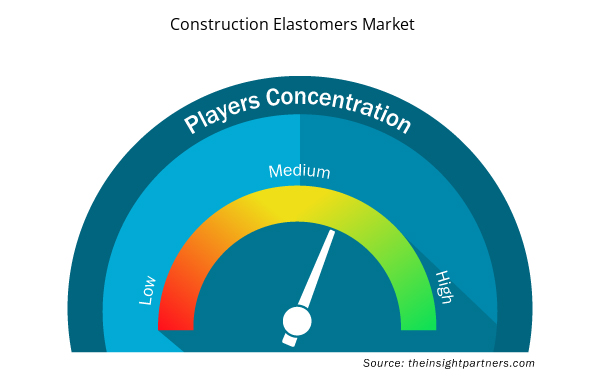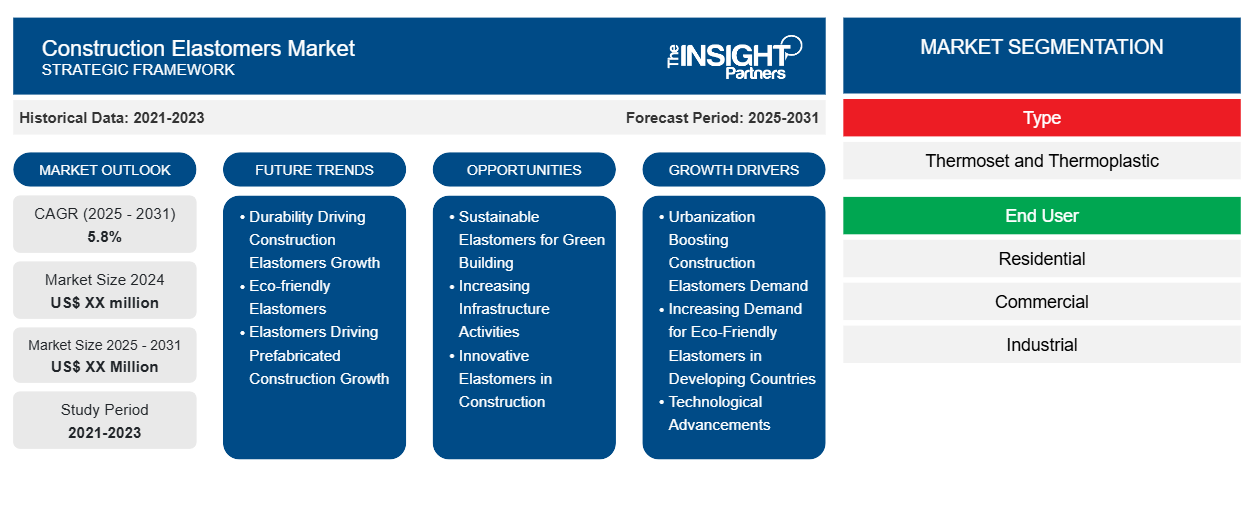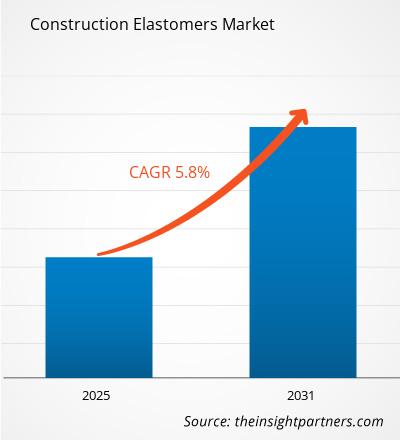Si prevede che il mercato degli elastomeri per l'edilizia registrerà un CAGR del 5,8% dal 2024 al 2031, con una dimensione di mercato in espansione da XX milioni di dollari nel 2024 a XX milioni di dollari entro il 2031.
Il report è segmentato per tipo (termoindurente e termoplastico). Il report è anche segmentato per utente finale (residenziale, commerciale, industriale, infrastruttura civile e altri). L'ambito del report copre 5 regioni: Nord America, Europa, Asia Pacifico, Medio Oriente e Africa, Sud e Centro America e paesi chiave in ogni regione. L'analisi globale è ulteriormente suddivisa a livello regionale e nei principali paesi. Il report offre il valore in USD per l'analisi e i segmenti di cui sopra.
Scopo del rapporto
Il report Construction Elastomers Market di The Insight Partners mira a descrivere il panorama attuale e la crescita futura, i principali fattori trainanti, le sfide e le opportunità. Ciò fornirà spunti a vari stakeholder aziendali, come:
- Fornitori/produttori di tecnologia: per comprendere le dinamiche di mercato in evoluzione e conoscere le potenziali opportunità di crescita, consentendo loro di prendere decisioni strategiche informate.
- Investitori: condurre un'analisi completa delle tendenze in merito al tasso di crescita del mercato, alle proiezioni finanziarie del mercato e alle opportunità esistenti lungo la catena del valore.
- Enti di regolamentazione: regolamentano le politiche e le attività di controllo sul mercato allo scopo di ridurre al minimo gli abusi, preservare la fiducia degli investitori e sostenere l'integrità e la stabilità del mercato.
Segmentazione del mercato degli elastomeri da costruzione
Tipo
- Termoindurenti e termoplastici
Utente finale
- Residenziale
- Commerciale
- Industriale
- Infrastruttura civile
Personalizza questo report in base alle tue esigenze
Riceverai la personalizzazione gratuita di qualsiasi report, comprese parti di questo report, o analisi a livello nazionale, pacchetto dati Excel, oltre a usufruire di grandi offerte e sconti per start-up e università
- Scopri le principali tendenze di mercato in questo rapporto.Questo campione GRATUITO includerà analisi di dati che spaziano dalle tendenze di mercato alle stime e alle previsioni.
Fattori trainanti della crescita del mercato degli elastomeri per l'edilizia
- L'urbanizzazione aumenta la domanda di elastomeri per l'edilizia: il mercato degli elastomeri per l'edilizia è fortemente influenzato da fattori come la rapida urbanizzazione e le attività infrastrutturali in corso. I centri urbani sempre più popolati richiedono la costruzione di strutture che portano alla necessità di questi materiali in grado di resistere a strappi e flessioni. Alcune delle ragioni per cui gli elastomeri sono adatti a diverse soluzioni di costruzione come coperture e isolamento termico sono le loro caratteristiche di resistenza all'abrasione e allo strappo.
- Domanda crescente di elastomeri ecocompatibili nei paesi in via di sviluppo: i paesi in via di sviluppo stanno anche assistendo a un aumento delle proprietà di elasticità poiché la maggior parte degli elastomeri deve conformarsi ai requisiti ambientali. I produttori stanno diversificando la loro considerazione degli elastomeri olefinici in quanto si concentrano anche commercialmente sulla loro produzione a un costo inferiore e con minori effetti sull'ambiente. Questo crescente utilizzo di questi materiali è incoraggiato dalla preoccupazione per l'ambiente che è dominata dai desideri principali esistenti nel mondo odierno.
- Progressi tecnologici: la tecnologia utilizzata nella produzione di elastomeri è cambiata e questo ha portato a miglioramenti nelle proprietà degli elastomeri, tra cui la gamma di resistenza all'impatto e l'allungamento. Questi sviluppi non fanno che aumentare la desiderabilità degli elastomeri per scopi di costruzione poiché possono essere sottoposti a condizioni difficili e rimanere efficaci per lungo tempo. Man mano che il mondo cambia e la tecnologia diventa avanzata, la necessità e il mercato degli elastomeri per l'edilizia stanno crescendo enormemente.
Tendenze future del mercato degli elastomeri da costruzione
- La durevolezza guida la crescita degli elastomeri da costruzione: una delle tendenze più notevoli nel mercato degli elastomeri da costruzione è la particolare attenzione data alla durevolezza e alla capacità di resistere agli effetti atmosferici. I materiali polimerici di oggi sono prodotti per resistere a temperature estreme, quindi sono applicabili in aree come tetti e sigillanti. Questo aggiornamento migliora le possibilità per quei costruttori che cercano prodotti di fascia alta per una costruzione durevole.
- Elastomeri ecocompatibili: il settore edile sta diventando più sostenibile, c'è una tendenza emergente in cui gli elastomeri vengono creati con materiali derivati da fonti riciclate o di origine biologica. Ciò non solo aderisce alle richieste ecologiche, ma anche alla ricerca da parte dei consumatori di tali alternative. Pertanto, tali elastomeri che sono ecocompatibili vengono preferiti nei lavori di costruzione.
- Elastomeri che guidano la crescita delle costruzioni prefabbricate: l'ascesa delle costruzioni prefabbricate sta aumentando il consumo di elastomeri poiché sono facili da installare e flessibili. Il desiderio di metodi di costruzione efficienti da parte dei costruttori ha migliorato le proprietà degli elastomeri per un assemblaggio rapido e design modulari. Questa tendenza sta rivoluzionando l'uso dei materiali nel settore delle costruzioni.
Opportunità di mercato degli elastomeri da costruzione
- Elastomeri sostenibili per l'edilizia ecologica: la crescente attenzione verso i lavori di costruzione ecosostenibili è una grande spinta per il mercato degli elastomeri. Man mano che i costruttori si rivolgono a pratiche di edilizia ecologica, c'è una crescente necessità di elastomeri ecosostenibili prodotti utilizzando materiali riciclati o di origine biologica. Ciò è in linea con le normative ambientali e la domanda di mercato per soluzioni di costruzione sostenibili.
- Aumento delle attività infrastrutturali: con l'urbanizzazione e lo sviluppo infrastrutturale in corso, la domanda di elastomeri in una gamma di applicazioni, tra cui strade, ponti, impermeabilizzazione e così via, rappresenta una grande opportunità. Inoltre, le loro caratteristiche, come l'altissima durata e flessibilità, li rendono adatti a tali progetti. Si prevede che tale domanda favorirà la crescita e l'avanzamento nelle formulazioni di rivestimenti elastomerici.
- Elastomeri innovativi nell'edilizia: c'è un crescente sviluppo della tecnologia degli elastomeri che rende possibile la produzione di materiali complessi per applicazioni edilizie. La mancanza modificata di facile usura e i miglioramenti nella protezione dall'invecchiamento contribuiscono entrambi alla diversificazione dell'uso. Con gli sviluppi della tecnologia, i fornitori sono in grado di fornire elastomeri personalizzati con diverse applicazioni nel settore edile.
Approfondimenti regionali sul mercato degli elastomeri per l'edilizia
Le tendenze regionali e i fattori che influenzano il mercato degli elastomeri da costruzione durante il periodo di previsione sono stati ampiamente spiegati dagli analisti di Insight Partners. Questa sezione discute anche i segmenti e la geografia del mercato degli elastomeri da costruzione in Nord America, Europa, Asia Pacifico, Medio Oriente e Africa e America centrale e meridionale.

- Ottieni i dati specifici regionali per il mercato degli elastomeri da costruzione
Ambito del rapporto di mercato sugli elastomeri da costruzione
| Attributo del report | Dettagli |
|---|---|
| Dimensioni del mercato nel 2024 | XX milioni di dollari USA |
| Dimensioni del mercato entro il 2031 | XX milioni di dollari USA |
| CAGR globale (2024 - 2031) | 5,8% |
| Dati storici | 2021-2023 |
| Periodo di previsione | 2025-2031 |
| Segmenti coperti | Per tipo
|
| Regioni e Paesi coperti | America del Nord
|
| Leader di mercato e profili aziendali chiave |
|
Densità degli attori del mercato degli elastomeri per l'edilizia: comprendere il suo impatto sulle dinamiche aziendali
Il mercato degli elastomeri da costruzione sta crescendo rapidamente, spinto dalla crescente domanda degli utenti finali dovuta a fattori quali l'evoluzione delle preferenze dei consumatori, i progressi tecnologici e una maggiore consapevolezza dei vantaggi del prodotto. Con l'aumento della domanda, le aziende stanno ampliando le loro offerte, innovando per soddisfare le esigenze dei consumatori e capitalizzando sulle tendenze emergenti, il che alimenta ulteriormente la crescita del mercato.
La densità degli operatori di mercato si riferisce alla distribuzione di aziende o società che operano in un particolare mercato o settore. Indica quanti concorrenti (operatori di mercato) sono presenti in un dato spazio di mercato in relazione alle sue dimensioni o al valore di mercato totale.
Le principali aziende che operano nel mercato degli elastomeri per l'edilizia sono:
- Arkema
- Giù
- Covestro AG
- Società a responsabilità limitata Huntsman International LLC
- Teknor Apex
Disclaimer : le aziende elencate sopra non sono classificate secondo un ordine particolare.

- Ottieni una panoramica dei principali attori del mercato degli elastomeri per l'edilizia
Punti di forza chiave
- Copertura completa: il rapporto copre in modo completo l'analisi di prodotti, servizi, tipologie e utenti finali del mercato degli elastomeri per l'edilizia, fornendo una panoramica olistica.
- Analisi degli esperti: il rapporto è compilato sulla base della conoscenza approfondita di esperti e analisti del settore.
- Informazioni aggiornate: il rapporto garantisce la pertinenza aziendale grazie alla copertura di informazioni recenti e tendenze nei dati.
- Opzioni di personalizzazione: questo report può essere personalizzato per soddisfare le esigenze specifiche del cliente e adattarsi in modo appropriato alle strategie aziendali.
Il rapporto di ricerca sul mercato degli elastomeri da costruzione può quindi aiutare a guidare il percorso di decodificazione e comprensione dello scenario del settore e delle prospettive di crescita. Sebbene possano esserci alcune preoccupazioni valide, i vantaggi complessivi di questo rapporto tendono a superare gli svantaggi.
- Analisi storica (2 anni), anno base, previsione (7 anni) con CAGR
- Analisi PEST e SWOT
- Valore/volume delle dimensioni del mercato - Globale, regionale, nazionale
- Industria e panorama competitivo
- Set di dati Excel


- Sterilization Services Market
- Retinal Imaging Devices Market
- Single Pair Ethernet Market
- Water Pipeline Leak Detection System Market
- Online Recruitment Market
- Hand Sanitizer Market
- Health Economics and Outcome Research (HEOR) Services Market
- Bio-Based Ethylene Market
- Skin Tightening Market
- Intraoperative Neuromonitoring Market

Report Coverage
Revenue forecast, Company Analysis, Industry landscape, Growth factors, and Trends

Segment Covered
This text is related
to segments covered.

Regional Scope
North America, Europe, Asia Pacific, Middle East & Africa, South & Central America

Country Scope
This text is related
to country scope.
Domande frequenti
Based on geography, Asia Pacific is expected to register the fastest CAGR from 2023 to 2031.
The report can be delivered in PDF/Word format, we can also share excel data sheet based on request.
Expansion in green building initiatives is one of the key opportunities for the market growth.
BASF SE, Dow, Covestro AG, Huntsman Corporation, Teknor Apex Company, Lubrizol Corporation, Tosh Corporation, Kraton Corporation, China Petroleum and Chemical Corporation, and Mitsubishi Chemical Company are among the leading players operating in the construction elastomers market.
Advancements in material technology is driving the market growth
The Construction Elastomers Market is estimated to witness a CAGR of 5.8% from 2023 to 2031
Trends and growth analysis reports related to Chemicals and Materials : READ MORE..
1. Arkema
2. Dow
3. Covestro AG
4. Huntsman International LLC.
5. Teknor Apex
6. The Lubrizol Corporation
7. KRATON CORPORATION
8. Mitsubishi Chemical Corporation
9. DuPont
10. Evonik
The Insight Partners performs research in 4 major stages: Data Collection & Secondary Research, Primary Research, Data Analysis and Data Triangulation & Final Review.
- Data Collection and Secondary Research:
As a market research and consulting firm operating from a decade, we have published and advised several client across the globe. First step for any study will start with an assessment of currently available data and insights from existing reports. Further, historical and current market information is collected from Investor Presentations, Annual Reports, SEC Filings, etc., and other information related to company’s performance and market positioning are gathered from Paid Databases (Factiva, Hoovers, and Reuters) and various other publications available in public domain.
Several associations trade associates, technical forums, institutes, societies and organization are accessed to gain technical as well as market related insights through their publications such as research papers, blogs and press releases related to the studies are referred to get cues about the market. Further, white papers, journals, magazines, and other news articles published in last 3 years are scrutinized and analyzed to understand the current market trends.
- Primary Research:
The primarily interview analysis comprise of data obtained from industry participants interview and answers to survey questions gathered by in-house primary team.
For primary research, interviews are conducted with industry experts/CEOs/Marketing Managers/VPs/Subject Matter Experts from both demand and supply side to get a 360-degree view of the market. The primary team conducts several interviews based on the complexity of the markets to understand the various market trends and dynamics which makes research more credible and precise.
A typical research interview fulfils the following functions:
- Provides first-hand information on the market size, market trends, growth trends, competitive landscape, and outlook
- Validates and strengthens in-house secondary research findings
- Develops the analysis team’s expertise and market understanding
Primary research involves email interactions and telephone interviews for each market, category, segment, and sub-segment across geographies. The participants who typically take part in such a process include, but are not limited to:
- Industry participants: VPs, business development managers, market intelligence managers and national sales managers
- Outside experts: Valuation experts, research analysts and key opinion leaders specializing in the electronics and semiconductor industry.
Below is the breakup of our primary respondents by company, designation, and region:

Once we receive the confirmation from primary research sources or primary respondents, we finalize the base year market estimation and forecast the data as per the macroeconomic and microeconomic factors assessed during data collection.
- Data Analysis:
Once data is validated through both secondary as well as primary respondents, we finalize the market estimations by hypothesis formulation and factor analysis at regional and country level.
- Macro-Economic Factor Analysis:
We analyse macroeconomic indicators such the gross domestic product (GDP), increase in the demand for goods and services across industries, technological advancement, regional economic growth, governmental policies, the influence of COVID-19, PEST analysis, and other aspects. This analysis aids in setting benchmarks for various nations/regions and approximating market splits. Additionally, the general trend of the aforementioned components aid in determining the market's development possibilities.
- Country Level Data:
Various factors that are especially aligned to the country are taken into account to determine the market size for a certain area and country, including the presence of vendors, such as headquarters and offices, the country's GDP, demand patterns, and industry growth. To comprehend the market dynamics for the nation, a number of growth variables, inhibitors, application areas, and current market trends are researched. The aforementioned elements aid in determining the country's overall market's growth potential.
- Company Profile:
The “Table of Contents” is formulated by listing and analyzing more than 25 - 30 companies operating in the market ecosystem across geographies. However, we profile only 10 companies as a standard practice in our syndicate reports. These 10 companies comprise leading, emerging, and regional players. Nonetheless, our analysis is not restricted to the 10 listed companies, we also analyze other companies present in the market to develop a holistic view and understand the prevailing trends. The “Company Profiles” section in the report covers key facts, business description, products & services, financial information, SWOT analysis, and key developments. The financial information presented is extracted from the annual reports and official documents of the publicly listed companies. Upon collecting the information for the sections of respective companies, we verify them via various primary sources and then compile the data in respective company profiles. The company level information helps us in deriving the base number as well as in forecasting the market size.
- Developing Base Number:
Aggregation of sales statistics (2020-2022) and macro-economic factor, and other secondary and primary research insights are utilized to arrive at base number and related market shares for 2022. The data gaps are identified in this step and relevant market data is analyzed, collected from paid primary interviews or databases. On finalizing the base year market size, forecasts are developed on the basis of macro-economic, industry and market growth factors and company level analysis.
- Data Triangulation and Final Review:
The market findings and base year market size calculations are validated from supply as well as demand side. Demand side validations are based on macro-economic factor analysis and benchmarks for respective regions and countries. In case of supply side validations, revenues of major companies are estimated (in case not available) based on industry benchmark, approximate number of employees, product portfolio, and primary interviews revenues are gathered. Further revenue from target product/service segment is assessed to avoid overshooting of market statistics. In case of heavy deviations between supply and demand side values, all thes steps are repeated to achieve synchronization.
We follow an iterative model, wherein we share our research findings with Subject Matter Experts (SME’s) and Key Opinion Leaders (KOLs) until consensus view of the market is not formulated – this model negates any drastic deviation in the opinions of experts. Only validated and universally acceptable research findings are quoted in our reports.
We have important check points that we use to validate our research findings – which we call – data triangulation, where we validate the information, we generate from secondary sources with primary interviews and then we re-validate with our internal data bases and Subject matter experts. This comprehensive model enables us to deliver high quality, reliable data in shortest possible time.


 Ottieni un campione gratuito per questo repot
Ottieni un campione gratuito per questo repot